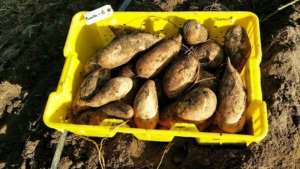By Jim Melvin
Thanks to a blissful stretch of blue skies and dry weather, at least 80 percent of the valuable crops at Clemson University’s Coastal Research and Education Center have weathered Hurricane Matthew’s wrath and rebounded with voracity.

Ongoing research trials that included broccoli, peanuts, sweet potatoes and watermelons all suffered far less of a setback than originally feared.
“We were forced to evacuate during Hurricane Matthew, and when we first returned to check out the damage, it looked to me like we had lost at least 50 percent of what we had in our fields,” said Brian Ward, research scientist at the REC who is one of the nation’s leading experts on crop experimentation. “The flooding and wind damage were worse than anything we had seen before – even worse than in (the floods of) 2015 – and the plants looked really bad. But unlike last year, the weather dried up immediately and has stayed dry, which created excellent conditions for healing. So it goes without saying that we’re very pleased with how things have turned out here.”

Hurricane Matthew, which slammed against South Carolina’s coast on Oct. 8, marked the second consecutive year that the REC was battered by a catastrophic weather event. The historic superstorm that ravaged South Carolina in 2015 occurred at virtually the same time as this year’s hurricane. However, the 2015 storm was followed in many parts of the state by at least 10 more days of rain, which ended up causing as much or more damage than the storm itself. Fields remained saturated and crops continued to die. This year, at least, most of the washout was contained to about a single day.
“Most of our crops rebounded very well,” Ward said. “With broccoli, we were growing 16 varieties and lost only three to six of those. With sweet potatoes, we did have some rotting – which we expected – but the majority of them fared well and has since been harvested. We’ve also harvested our fall watermelons, and now we’re processing the peanuts by hand-pulling them off the vines. The peanuts, especially, have fared much better than we had anticipated.”

Because of the timing of the storm, there was more good news. The ongoing process of reviving Purple Straw – a valuable heirloom wheat that Ward is helping to bring back from the brink of extinction – was unaffected by the hurricane, for one simple reason: The seed hadn’t been planted yet. Ward originally planted one-half pound of seed in late 2015 that resulted in about 100 pounds when harvested in May 2016. He will begin Year 2 of the process about a week from now.
“I’ll probably plant about 75 pounds of seed and keep the rest for security purposes,” Ward said. “And we’ll use fields that were high and dry and have no risk of contamination from saltwater. When we harvest in May 2017, we should get between 500 and 1,000 pounds – and maybe even more. Then, if all goes well, Year 3 will produce several thousand pounds and the revival will be a success.”
The good news that came out of the REC did not extend to the entirety of the Lowcountry. Some farmers in this area suffered significant damage to their crops, with cotton and rice appearing to absorb the heaviest blows. The full extent won’t be apparent until the fall harvest season ends in early December, and official statewide statistics might take months to compile.
Source: clemson.edu